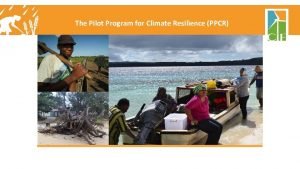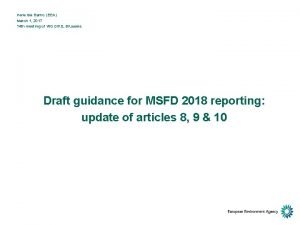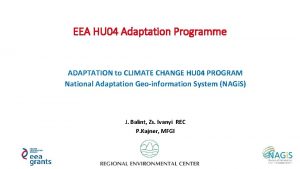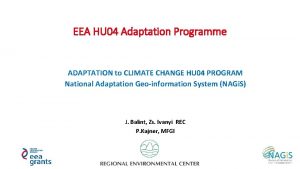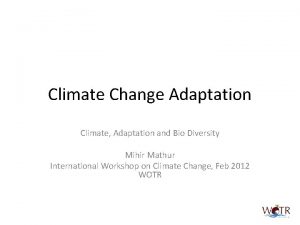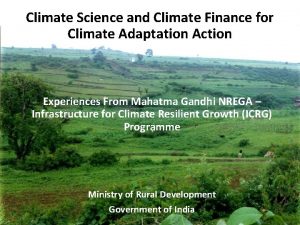EEA HU 04 Adaptation Programme ADAPTATION to CLIMATE









- Slides: 9

EEA HU 04 Adaptation Programme ADAPTATION to CLIMATE CHANGE HU 04 PROGRAM National Adaptation Geo-information System (NAGi. S) J. Balint, Zs. Ivanyi REC P. Kajner, MFGI

EEA Grant • financial mechanisms established by Iceland, Liechtenstein and Norway. • the donor states are EEA members but not EU members => they do not contribute financially to the common policies of the EU. • the grants are designed to encourage bilateral cooperation and project partnerships with 15 EU countries, including Hungary, and reduce economic and social disparities within the EEA. • June 6, 2013, the EEA Grants approved the Adaptation to Climate Change programme area with REC as the fund operator • total funding EUR 7, 010, 000, deadline April 30, 2017. • aims to promote a clear understanding of CC impacts and vulnerability in Hungary; encourage actions to improve climate resilience at local level; raise awareness of CC impacts; and share examples of replicable projects that contribute to reducing the impacts of CC.

HU 04 Adaptation Programme • The Programme Operator: Financial Mechanism Office, FMO • The Fund Operator: The Regional Environmental Center for Central and Eastern Europe, REC • The Programme partner: Directorate for Civil Protection and Emergency Planning (DSB) based in Norway and acting as Donor Programme Partner (DPP). The programme intends to address the “adaptation challenge” with three different components which are inter-related to each other: C 1 - Establishing a sound base for supporting adaptation related decision making - National Adaptation Geographical Information System-NAGi. S C 2 - Capacity building/awareness raising C 3 - Pilot projects • Bilateral activities

Objectives of the NAGi. S – 1 Create a multipurpose geo-information system that can support the policy-making, strategy-building and decisionmaking process related to the impact assessment of climate change and elaborating necessary adaptation actions for Hungary. • fulfilling climate change laws, regulations and meeting policy expectations • developing a complex methodology for the analysis of climate change impacts • quantitative analysis of vulnerability for the whole chain of impacts (exposure, sensitivity, adaptation capacity) • Providing with data for impact assessments – results for sectorial and territorial planning and adaptation strategies

Objectives of the NAGi. S – 2 • • • up-to-date, objective information for climate change policy, territorial planning exploring local adaptation possibilities, helping municipality level climate strategy planning and implementation integration of data generated by governmental institutions, building a meta-database and development of a geoinformation system Creating sectoral indicators for decision-making and planning query and visualisation systems for strengthening national, regional and local adaptation potentials dissemination of information and knowledge, awareness raising Impact of climate change in the past 45 years Difference in precipitation (2005 -2009/1961 -65) Groundwater tables of Hungary created by numerical modelling

RESULT: Integrated policy databases for queries managed by Geo. Dat Task and added value: • • • Multifunctional, up-to-database A flexible tool to support decisionmaking Promoting policy planning Directions of development: • • • An information module for policy makers A module for making reports and for supporting preparing for daily tasks of policy -making A module for municipalities

KRITéR • Excess mortality caused by extreme heath waves • Road accidents • tourism RCMTéR Data layers decision making support Local gov. • Development of climate model- data • Quantifying climate projections uncertainty • Model data processing for climate • impact assessments Inhabitants, general public Hungary's long-term social and economic development trajectory forecast • Modeling socio economic processes up to 2050: • demography • economy • Land use Economic decision makers Research AGRATéR • arable land, forest, grassland Indicators • Changes in land use • effects on the agricultural sector • arable land, forests, grasslands vulnerability assessment methodology • zántó, erdő, gyep indikátorok • földhasználat változása Data layers Universities, research institutions

Application possibilities of the NAGIS In national, local and sectoral strategical planning Climate policy, energy policy, green industry development, agricultural and rural development, disaster protection/control Supporting policies in focus, identification of intervention areas, supporting strategic planning Local and regional climate strategy planning Climate protection strategies of settlements and rural areas/regions and adaptation Touristic planning The impact of climate change on touristic destinations Health and quality of life related planning Preparing for extreme climatic events (ex. Heath waves)

Thank you for your attention! www. rec. org www. eea. rec. org http: //nagis. hu


